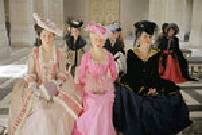|
|
||||
|
|
by Betty Jo Tucker  Filmmaker Sofia Coppola introduces viewers to a naïve teenage girl not ready to be Queen of France in Marie Antoinette, a movie more in tune with the 21st century than the historic time in which Marie lived. Think Pretty in Pink meets Elizabeth, but without the clarity and entertainment value of either film. Still, casting Kirsten Dunst (The Cat’s Meow) in the lead role here makes sense. She excels at projecting the bewilderment of a young girl suddenly placed in a position of such high visibility. And she looks absolutely stunning in those elaborate period costumes designed by Milena Canonero (Barry Lyndon). Dunst portrays the Austrian princess who, in her early teens, is forced into an arranged marriage to the Dauphin (Jason Schwartzman), a teenager destined to become King Louis XVI. Sadly -- though not unusual in the 17th century -- these youngsters are merely pawns to bring about closer ties between their two countries. Marie moves to Louis shows little interest in Marie (the marriage goes on for years -- as does this movie, it seems -- before being consummated), so she takes a lover (Jamie Dornan), which gives the gossip-mongers even more fodder. Marie soon becomes the talk of Instead of a stodgy historical epic, Coppola set out to create a more modern and upbeat movie -- even to the point of adding contemporary background music by such artists as The Cure and Bow Wow Wow, whose haunting rendition of “Fools Rush In” turned out to be the best thing about Marie Antoinette for me. “I wanted this film to let the audience feel what it might be like to be in Coppola describes her vision of Marie as “mostly a good-hearted, creative person who was unaware of the world outside of Despite its opulent settings and Dunst’s fine performance, Marie Antoinette didn’t work for me. Lacking a serious tone more appropriate for its historical subject matter, the film left me with an empty feeling -- and yet, surprisingly, with little desire to learn anything more about the life and times of Marie Antoinette. (Released by Columbia Pictures and rated “PG-13” for sexual content, partial nudity and innuendo.)
|
||
|
© 2025 - ReelTalk Movie Reviews Website designed by Dot Pitch Studios, LLC |




